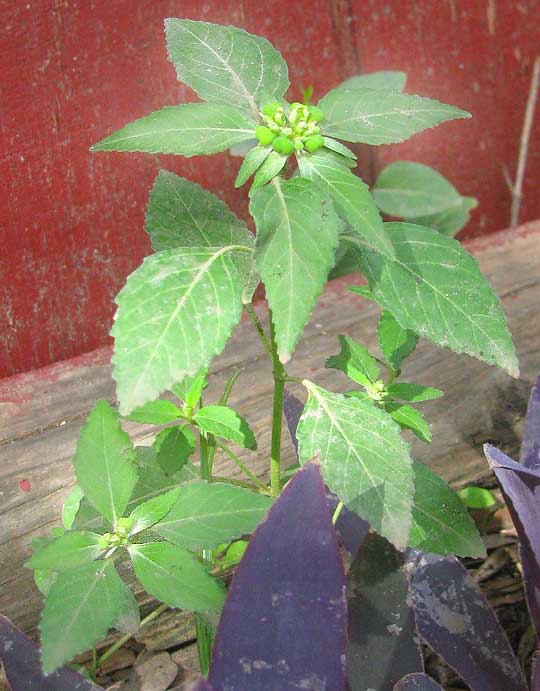Excerpts from Jim Conrad's
Naturalist Newsletter
from the September 15, 2013 Newsletter issued from the Frio Canyon Nature Education Center in the valley of the Dry Frio River in northern Uvalde County, southwestern Texas, on the southern border of the Edwards Plateau; elevation ~1750m (~5750 ft); N29.62°, W99.86°; USA
TOOTHED SPURGE
Around here the only place I've seen the Toothed Spurge, EUPHORBIA DENTATA, is in the regularly watered flower garden behind the red cabin I lived in last winter. Below, you can see the plant rising above some Purple Spiderwort, which is what I'd been watering:

The "toothed" part of the name derives from the toothed or serrated leaf margins. Lots of leaves are toothed, but toothiness isn't common among spurges. The name "spurge" is applied to many members of the genus Euphorbia in the Spurge or Euphorbia Family, the Euphorbiaceae. Below, you can see why the Toothed Spurge definitely is a spurge with a close look at the center of the plant's flowering top:

Basic spurge flower anatomy is demonstrated by the Christmas Poinsettia -- also a member of the genus Euphorbia -- which places its female, or "pistillate," flowers on stems that curve over the rim of a bowl-like "cyathia." You can see this in Poinsettia, with labeled parts, at http://www.backyardnature.net/chiapas/poinset6.jpg.
The Toothed Spurge's basic arrangement is almost identical to the Poinsettia's. In fact, Toothed Spurges remind us of Poinsettias, only that instead of leaves surrounding the flowering zone displaying red, they're blushed with white.
In the last photo you see several female flowers with their green ovaries hanging outside their smaller cyathia. Cyathia aren't reduced flowers, but rather bowl-shaped receptacles containing several tiny male flowers and one female flower. The female flower's relatively gigantic ovary is banished to outside the cyathium. Each male flower bears just a single stamen. In the picture, at the base of each ovary's stem and along the cyathia's rims you see several bilobed, slightly yellowish anthers atop short, white filaments. Each anther represents a male flower. On the side of each cyathium opposite where the ovary's stem crosses the cyathium's rim you see shiny, dark green items looking like little tongues sticking out. These are "cyathial glands," producing nectar for pollinators.
This unique strategy of clustering tiny, unisexual flowers into a radially symmetrical cyathium, with the single female flower dangling its ovary outside the cyathium, is found only in the genus Euphorbia (bilaterally symmetrical cyathia occur in the genus Pedilanthus). However, that's still a lot of species with such cyathia, since up to 2000 Euphorbia species are recognized worldwide.
In the US, Toothed Spurges occur coast-to-coast in the southern half of the country, plus south through Mexico, as well as in South America. It's established itself in numerous countries across the world.